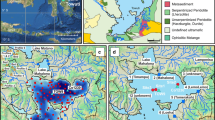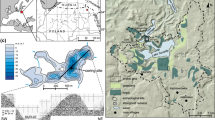Abstract
Increased erosion triggered by land-use changes is a major process that influences lake sedimentation. We explored the record of erosion intensity in annually laminated sediments of Lake Żabińskie, northeast Poland. A 1000-year-long, annually resolved suite of sedimentological (varve thickness, sediment accumulation rate) and geochemical data (scanning XRF, loss on ignition, biogenic silica) was analyzed with multivariate statistics. PCA indicated erosion was a major process responsible for changes in the chemical composition of the sediments. Analysis of sedimentary facies enabled identification of major phases of erosion that influenced lake sedimentation. These phases are consistent with the history of land use, inferred from pollen analysis. From AD 1000 to 1610, conditions around and in Lake Żabińskie were relatively stable, with low erosion intensity in the catchment and a dominance of carbonate sedimentation. Between AD 1610 and 1740, higher lake productivity and increased delivery of minerogenic material were caused by development of settlements in the region and widespread deforestation. The most prominent changes were observed between AD 1740 and 1880, when further land clearance and increased agricultural activity caused intensified soil erosion and higher lake productivity. Landscape clearance also created better conditions for water column mixing, which led to changes in redox conditions in the hypolimnion. The most recent period (AD 1880–2010) was characterized by partial reforestation and a gradual decrease in the intensity of erosional processes.






Similar content being viewed by others
References
Arnaud F, Révillon S, Debret M, Revel M, Chapron E, Jacob J, Giguet-Covex C, Poulenard J, Magny M (2012) Lake Bourget regional erosion patterns reconstruction reveals Holocene NW European Alps soil evolution and paleohydrology. Quat Sci Rev 51:81–92
Aufgebauer A, Panagiatopoulos K, Wagner B, Schaebitz F, Viehberg FA, Vogel H, Zanchetta G, Sulpizio R, Leng MJ, Damaschke M (2012) Climate and environmental change over the last 17 ka recorded in sediments from Lake Prespa (Albania/F.Y.R. of Macedonia/Greece). Quat Int 274:122–135
Augustsson A, Gaillard MJ, Pelota P, Mazier F, Bergbäck B, Saarinen T (2013) Effects of land use and climate change on erosion intensity and sediment geochemistry at Lake Lehmilampi, Finland. Holocene 23:1247–1259
Balascio N, Zhang Z, Bradley R, Perren B, Dahl S, Bakke J (2011) A multi-proxy approach to assessing isolation basin stratigraphy from the Lofoten Islands, Norway. Quat Res 75:288–300
Białuński G (2002) Kolonizacja “Wielkiej Puszczy” (do 1568 roku): starostwa piskie, ełckie, straduńskie, zelkowskie i węgoborskie (węgorzewskie). Rozprawy i Materiały Ośrodka Badań Naukowych im. W. Kętrzyńskiego w Olsztynie nr 159, Olsztyn (in Polish)
Boës X, Rydberg J, Martínez-Cortizas A, Bindler R, Renberg I (2011) Evaluation of conservative lithogenic elements (Ti, Zr, Al, and Rb) to study anthropogenic element enrichments in lake sediments. J Paleolimnol 46:75–87
Bonk A, Tylmann W, Amann B, Enters D, Grosjean M (2015a) Modern limnology and varve-formation processes in Lake Żabińskie, northeastern Poland: comprehensive process studies as a key to understand the sediment record. J Limnol 74:358–370
Bonk A, Tylmann W, Goslar T, Wacnik A, Grosjean M (2015b) Comparing varve counting and 14C-AMS chronologies in the sediments of Lake Żabińskie, Poland: implications for accurate 14C dating of lake sediments. Geochronometria 42:159–171
Bork HR, Lang A (2003) Quantification of past soil erosion and land use/land cover changes in Germany. In: Lang A, Heinrich K, Dikau R (eds) Long term hillslope and fluvial system modelling: concepts and case studies from the rhine river catchment—lecture notes in earth sciences. Springer, Heidelberg, pp 232–239
Boyle JF (2001) Inorganic geochemical methods in paleolimnology. In: Last WM, Smol JP (eds) Tracking environmental change using lake sediments. Physical and geochemical methods, vol 2. Kluwer Academic Publishers, Dordrecht, pp 83–141
Brauer A, Endres C, Negendank JFW (1999) Lateglacial calendar year chronology based on annually laminated sediments from Lake Meerfelder Maar, Germany. Quat Int 61:17–25
Butz C, Grosjean M, Fischer D, Wudnerle S, Tylmann W, Rein B (2015) Hyperspectral imaging spectroscopy: a promising method for the biogeochemical analysis of lake sediments. J Appl Remote Sens 9:096031
Corella JP, Brauer A, Mangili C, Rull V, Vegas-Vilarrúbia T, Morellón M, Valero-Garcés BL (2012) The 1.5-ka varved record of Lake Montcortès (southern Pyrenees, NE Spain). Quat Res 78:323–332
Croudace IW, Rindby A, Rothwell RG (2006) ITRAX: description and evaluation of a new multi-function X-ray core scanner. In: Rothwell RG (ed) New techniques in sediment core analysis. Geological society special publication 267. Geological Society of London, London, pp 51–63
Czymzik M, Brauer A, Dulski P, Plessen B, Naumann R, Von Grafenstein U, Scheffler R (2013) Orbital and solar forcing of shifts in Mid- to Late Holocene flood intensity from varved sediments of pre-alpine Lake Ammersee (southern Germany). Quat Sci Rev 61:96–110
Davies SJ, Lamb HF, Roberts SJ (2015) Micro-XRF core scanning in palaeolimnology: recent developments in paleoenvironmental research. In: Croudace IW, Rothwell RG (eds) Micro-XRF studies of sediment cores applications of a non-destructive tool for the environmental sciences. Springer, Dordrecht, pp 189–226
Dearing JA (1991) Lake sediment records of erosional processes. Hydrobiologia 214:99–106
Dörfler W, Feeser I, Van den Bogaard C, Dreibrodt S, Erlenkeuser H, Kleinmann A, Merkt J, Wiethold J (2012) A high-quality annually laminated sequence from Lake Belau, Northern Germany: revised chronology and its implications for palynological and tephrochronological studies. Holocene 22:1413–1426
Edwards KJ, Whittington G (2001) Lake sediments, erosion and landscape change during the Holocene in Britain and Ireland. Catena 42:143–173
Engstrom DR, Wright HE (1984) Chemical stratigraphy of lake sediments as record of environmental change. In: Haworth EY, Lund JWG (eds) Lake sediments and environmental history. Leicester University Press, Leicester, pp 11–67
Enters D, Dörfler W, Zolitschka B (2008) Historical soil erosion and land-use change during the past two millennia recorded in the lake sediments of Frickenhauser See, northern Bavaria, central Germany. Holocene 18:243–254
Fernández M, Björck S, Wohlfarth B, Maidana NI, Unkel I, Van der Putten N (2013) Diatom assemblage changes in lacustrine sediments from Isla de los Estados, southernmost South America, in response to shifts in southwesterly wind belt during the last glaciation. J Paleolimnol 50:433–446
Hammer Ø, Harper DAT, Ryan PD (2001) PAST: paleontological statistics software package for education and data analysis. Palaeontol Electron 4:1–9
Heiri O, Lotter AF, Lemcke G (2001) Loss on ignition as a method for estimating organic and carbonate content in sediments: reproducibility and comparability if results. J Paleolimnol 25:101–110
Jolliffe I (2002) Principal component analysis. Springer, New York, p 487
Kinder M, Tylmann W, Enters D, Piotrowska N, Poręba G, Zolitschka B (2013) Construction and validation of calendar-year time scale for annually laminated sediments: an example from Lake Szurpiły (NE Poland). GFF 135:248–257
Kossert A (2009) Prusy Wschodnie: Historia i mit. Wydawnictwo Naukowe Scholar, Warszawa (in Polish)
Litt T, Krastel S, Sturm M, Kipfer R, Örcen S, Heumann G, Franz SO, Ülgen UB, Niessen F (2009) ‘PALEOVAN’, international continental scientific drilling program (ICDP): site survey results and perspectives. Quat Sci Rev 28:1555–1567
Marshall MH, Lamb HF, Huws D, Davies SJ, Bates R, Bloemendal J, Boyle J, Leng MJ, Umer M, Bryant C (2011) Late pleistocene and Holocene drought events at Lake Tana, the source of Blue Nile. Glob Planet Change 78:147–161
Martin-Puertas C, Brauer A, Dulski P, Brademann B (2012) Testing climate-proxy stationarity throughout the Holocene: an example from the varved sediments of Lake Meerfelder Maar. Quat Sci Rev 58:56–65 (in Germany)
Messerli B, Grosjean M, Hofer T, Núñez L, Pfister C (2000) From nature-dominated to human-dominated environmental changes. Quat Sci Rev 19:459–479
Meyer-Jacob C, Vogel H, Boxberg F, Rosén P, Weber ME, Bindler R (2014) Independent measurement of biogenic silica in sediments by FTIR spectroscopy and PLS regression. J Paleolimnol 52:245–255
Murtagh F, Legendre P (2014) Ward’s hierarchical agglomerative clustering method: which algorithms implement ward’s criterion? J Classif 31:274–295
Naeher S, Smittenberg RH, Gilli A, Kirilova EP, Lotter AF, Schubert CJ (2012) Impact of recent lake eutrophication on microbial community changes as revealed by high resolution lipid biomarkers in Rotsee (Switzerland). Org Geochem 49:86–95
Naeher S, Gilli A, North RP, Hamann Y, Schubert CJ (2013) Tracing bottom water oxygenation with sedimentary Fe/Mn ratios in Lake Zurich, Switzerland. Chem Geol 352:125–133
Ohlendorf C, Sturm M (2008) A modified method of biogenic silica determination. J Paleolimnol 54:137–142
Ott I, Rakko A, Sarik D, Nõges P, Ott K (2005) Sedimentation rate of seston during the formation of temperature stratification after ice break-up in the partly meromictic Lake Verevi. Hydrobiologia 547:51–61
Quinton JN, Govers G, Van Oost K, Bardgett RD (2010) The impact of agricultural soil erosion on biogeochemical cycling. Nat Geosci 3:311–314
Reimann C, Filzmoser P, Garrett R, Dutter R (2008) Statistical data analysis explained: applied environmental statistics with R. Wiley, Chichester
Simonneau A, Chapron E, Vanniere B, Wirth SB, Gilli A, Di Giovanni C, Anselmetti FS, Desmet M, Magny M (2013) Mass-movement and flood-induced deposits in Lake Ledro, southern Alps, Italy: implications for Holocene palaeohydrology and natural hazards. Clim Past 9:825–840
Srokowski S (1945) Prusy Wschodnie. Studium geograficzne, gospodarcze i społeczne. Wydawnictwa Instytutu Bałtyckiego, Gdańsk (in Polish)
Szumański A (2000) Objaśnienia do Szczegółowej Mapy Polski. Arkusz Giżycko (104). Państwowy Instytut Geologiczny, Warszawa
Töppen M (1870) Historia Mazur. Przyczynek do dziejów Krainy i kultury pruskiej (Geschichte Masurens. Ein Beitrag zur preußischen Landes- und Kulturgeschichte) (trans: Szymańska-Jasińska M Jasiński G (eds) (1995) Borussia, Olsztyn (in Polish)
Tylmann W, Szpakowska K, Ohlendorf C, Woszczyk M, Zolitschka B (2012) Conditions for deposition of annually laminated sediments in small meromictic lakes: a case study of Lake Suminko (northern Poland). J Paleolimnol 47:55–70
Tylmann W, Enters D, Kinder M, Moska P, Ohlendorf C, Poręba G, Zolitschka B (2013) Multiple dating of varved sediments from Lake Łazduny, northern Poland: toward an improved chronology for the last 150 year. Quat Geochronol 15:98–107
Tylmann W, Bonk A, Goslar T, Wulf S, Grosjean M (2016) Calibrating 210Pb dating results with varve chronology and independent chronostratigraphic markers: problems and implications. Quat Geochronol 32:1–10
Veski S, Koppel K, Poska A (2005) Integrated palaeoecological and historical data in the service of fine-resolution land use and ecological change assessment during the last 1000 years in Rõuge, southern Estonia. J Biogeogr 32:1473–1488
Vogel H, Rosén P, Wagner B, Melles M, Persson P (2008) Fourier transform infrared spectroscopy, a new cost-effective tool for quantitative analysis of biogeochemical properties in long sediment records. J Paleolimnol 40:689–702
Wacnik A, Tylmann W, Bonk A, Goslar T, Enters D, Meyer-Jacob C, Grosjean M (2016) Determining the responses of vegetation to natural processes and human impacts in north-eastern Poland during the last millennium: combined pollen, geochemical and historical data. Veg Hist Archaeobot 25:479–498
Wakar A, Wilamowski B (1968) Węgorzewo z dziejów miasta i powiatu. Pojezierze, Olsztyn (in Polish)
Wilkinson BH (2005) Humans as geologic agents: a deep-time perspective. Geology 33:161–164
Wolfe AP, Hobbs WO, Birks HH, Briner JP, Holmgren SU, Ingólfsson Ó, Kaushal SS, Miller GH, Pagani M, Saros JE, Vinebrooke RD (2013) Stratigraphic expressions of the Holocene: anthropocene transition revealed in sediments from remote lakes. Earth Sci Rev 116:17–34
Zolitschka B (2003) Human and climatic impact on the environment as derived from colluvial, fluvial and lacustrine archives: examples from the Bronze Age to the Migration period, Germany. Quat Sci Rev 22:81–100
Zolitschka B, Francus P, Ojala AEK, Schimmelmann A (2015) Varves in lake sediments: a review. Quat Sci Rev 117:1–41
Acknowledgments
We thank the CLIMPOL project members, in particular Agnieszka Wacnik, for providing palynological data, their support and comments on this manuscript. This study was supported by a grant from Switzerland through the Swiss Contribution to the enlarged European Union, Project CLIMPOL (PSPB-086/2010).
Author information
Authors and Affiliations
Corresponding author
Rights and permissions
About this article
Cite this article
Bonk, A., Kinder, M., Enters, D. et al. Sedimentological and geochemical responses of Lake Żabińskie (north-eastern Poland) to erosion changes during the last millennium. J Paleolimnol 56, 239–252 (2016). https://doi.org/10.1007/s10933-016-9910-6
Received:
Accepted:
Published:
Issue Date:
DOI: https://doi.org/10.1007/s10933-016-9910-6




